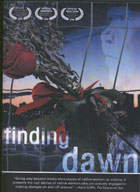
Finding Dawn 2006
Distributed by Women Make Movies, 462 Broadway, New York, NY 10013; 212-925-0606
Produced by Svend-Erik Eriksen
Directed by Christine Welsh
DVD, color, 73 min.
Jr. High - Adult
Ethnic Studies, Gender Studies, Human Rights, Native American Studies, Women's Studies
Date Entered: 11/03/2009
Reviewed by Kayo Denda, Rutgers UniversityThis powerful documentary directed by the acclaimed Native Canadian filmmaker Christine Welsh addresses epidemic violence against native women in Canada and the little attention that the authorities dedicate to solving their disappearances. Dawn Crey, Ramona Wilson and Daleen Bosse are among the 500 aboriginal women who went missing or murdered in the last thirty years. Their disappearance illustrates the deep social, economic, and historical factors that contribute to violence against women, as well as the marginalization of the aboriginal population in Canadian society.
The strength of the film lies in the candid accounts of the family members of the disappeared women, together with other Native Canadian women activists. Extreme poverty, abuse, and lack of opportunity force women to migrate to large cities where they end up on the streets as sex workers. While these accounts are deeply troublesome and somber, the documentary also shows signs of hope. The activism demonstrated by Native Canadian groups and their efforts to transform and rebuild the community are uplifting. Marlene Trick organizes the “Annual Women’s Memorial March” on Valentine’s Day in downtown Vancouver to honor and to express love for the disappeared sex workers. The “Take Back the Highway” event honors unresolved murders on Highway 16 and provides healing, support and strength not only to the victims’ families, but to the entire community. Janice Acooce and Fay Blaney speak of extreme poverty and violence they experienced at an early age that forced them to flee their communities. At the same time they express their profound sense of pride and identity with the land and cultural heritage. As a journalist, Janice has been outspoken about the invisibility of native women victims in mainstream media outlets. Fay serves on the Women’s Action Committee in her community which addresses violence and gang rape while raising awareness among the community members.
This film enables audiences to engage in questions about indigenous populations and the intersection between class and gender in the Canadian context and beyond, especially the fundamental notion that violence against women is everyone’s responsibility.